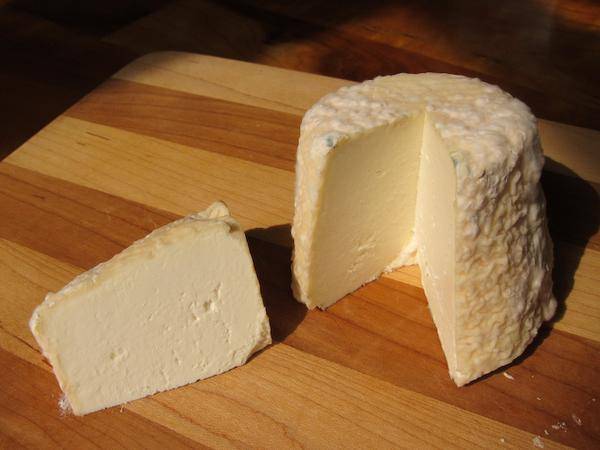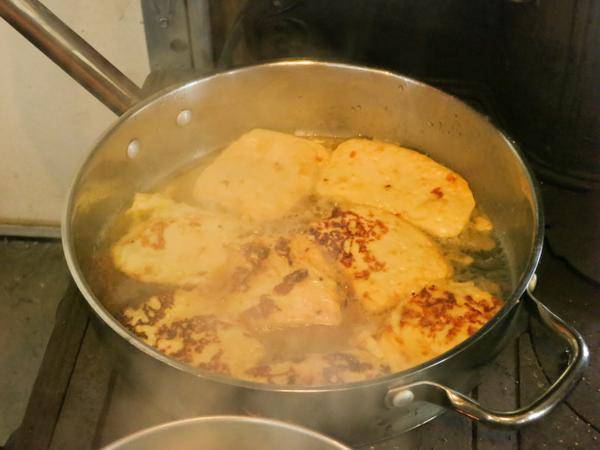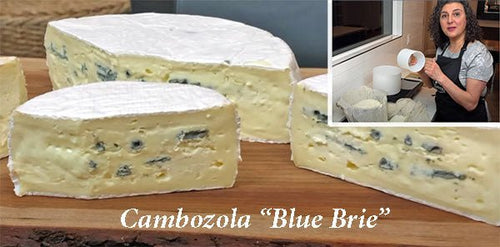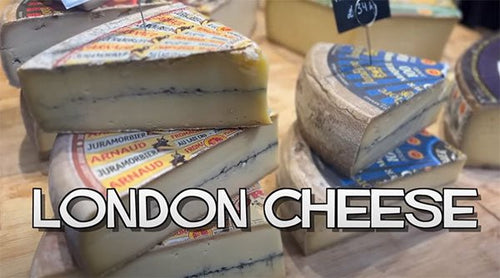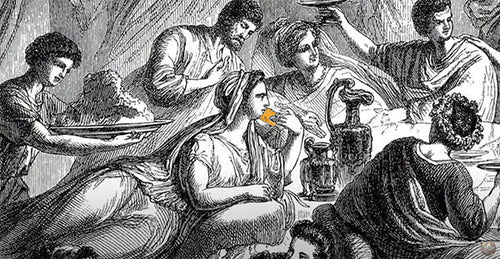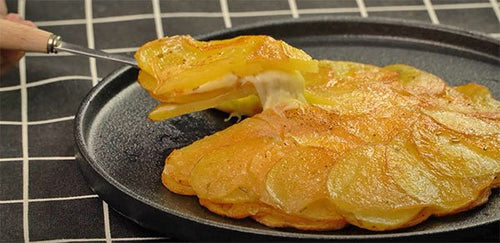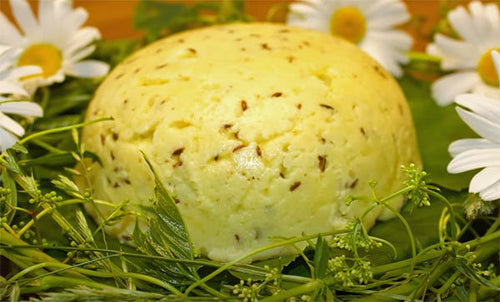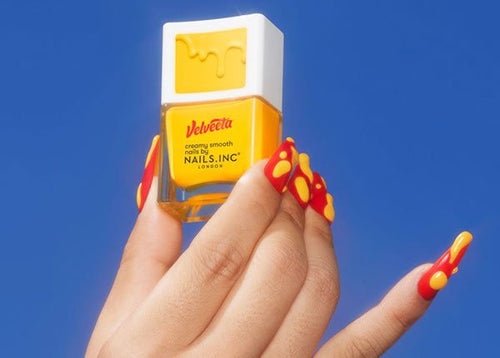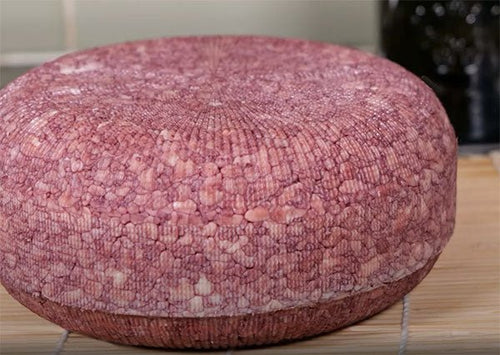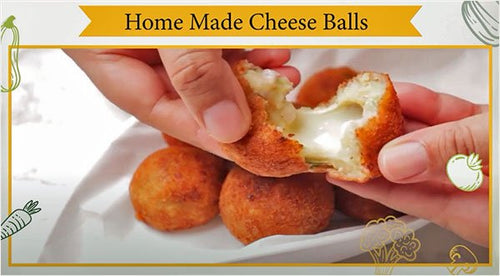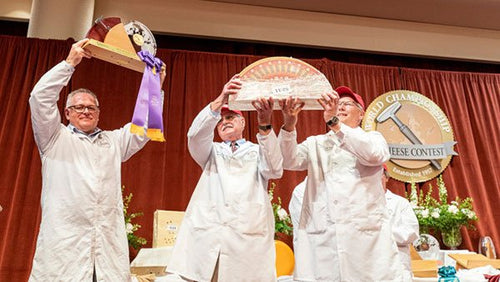Cheese Making Recipe of the Month
It's a Camembert?.. No!..It's a Blue?.. No Again! It's CamBlu!
This month, Jim has prepared a special recipe - a wonderful hybrid of Camembert with a little Blue on the inside. It took him a lot of trials to get it right (take a look at the end of the recipe page), but it was worth it!
If you have never had this cheese before, it really demonstrates how "the sum CAN be greater than the parts."
For those of you who want something to work toward, this should pique your interest, and for those of you just starting out, this shows you how far you can go. Jim wants you to know that this was a real challenge which kept him busy the past few months and he hopes you love it.
Meet a Fellow Cheese Maker
Erik Diemer, 15
(Is this "Generation WOW?!")
Erik Diemer makes cheese and teaches cheese making at his mother's "cupcakery" - Kitchen Chemistry in Stroudsburg, Pennsylvania.
What is a "cupcakery?" Well, from the pictures we have seen, it seems to be a store where everything in the world that tastes good is located!
When his mother, Lisa first began selling cheese making supplies and teaching classes, Erik took the pictures. But, then he began making his own cheese and now he teaches the classes himself.
He has adapted recipes for 30 Minute Mozzarella and for what he calls "20 Minute Farmer's Cheese"* for teaching his classes and demos.
Erik is also a DJ, a beekeeper, a photographer, a duct tape artist and a buyer and seller of coins!
News From Fellow Cheese Makers
Brenda Best
Height Challenged?
Hi, This is my perch while I make our cheese. We're on our 3rd year. This was to be Ron's hobby cause I do beer and wine. But, I like to help. I have a Colby in the fridge that I am counting the days to try.
For the Cotswold and Pepper-Jack, I have to wait til the end of February. And the Colby at least til the first week of March. I did two each so I can have one soon and keep the other one for the entire aging time.
Ron made two Manchegos. He did two last year and we had them this January. I made sausage Alfredo, and had to use A LOT of it for the sauce. Very good. Am so glad we started to do cheese. We love cheese.
Brenda Best, Wilkinson, Indiana
Bob & Joyce Wetmore with their grandkids
Making Mozzarella in Pakistan!
We received this note from Bob right before we posted a blog article about Imran Saleh, a Pakistani who is making the same cheese (Mozzarella) in the same city (Lahore)!
I am an American living in Pakistan and that means that it is hard to get real Mozzarella cheese that doesn't cost a fortune. Therefore I started using your thermometer and rennet and citric acid.
To make cheese from 2 gallons of very rich buffalo milk, I use ½ rennet tablet and 3 teaspoons of citric acid. I have always tried to follow your instructions carefully, because when I make mistakes (because I do this early in the mornings and am a bit groggy at times) I end up with something like Ricotta cheese.
Anyway, when I put the ½ rennet tablet in your recipes with ½ cup of water, the curd is perfect, just like in your video and in your pictures.I noticed on the package for the rennet tablets, however, that it said put ½ rennet tablet for 2 gallons of milk with ¼ cup of water. Well, I must have been crazy, but I figured I would experiment with my 2 gallons of milk.
When I mixed the ¼ cup of water with the ½ rennet tablet in it, the milk immediately completely curdled. The curd sank down and the liquid covered it. "Oh boy!" I thought to myself. "Ricotta cheesecake tonight!" But I kept on with the rest of the instructions.
Lo and behold! When I put it in the microwave, it came out to be the best Mozzarella cheese I have ever made.
Usually, for two gallons of milk, I get almost a quart of very rich milk that comes out of the cheese as I microwave it and stretch it.
This time I got maybe ½ cup of milk at the most. That made the cheese the richest ever! AND it stretched better than it had ever stretched before, by far.
I have done this twice now and both times it worked great.
It may be something to do with buffalo milk or some other strange thing, but I just thought you might be interested.
I can honestly say that the only thing that I miss about the U.S. (besides our family) is cheese and specifically Mozzarella cheese for pizza. Since your wonderful supplies have come into our lives, I am much happier living in Pakistan (this is our fifth year here). Thanks so much.
This evening I served up six pizzas for our ex-patriot community here in Lahore made with your glorious buffalo milk Mozzarella cheese. They were all absolutely amazed at how delicious it is.
Bob Wetmore, Forman Christian College, Lahore, Pakistan
Response from Jim Wallace
We forwarded this note to Jim, our technical advisor, and he responded:
Hi Bob, lucky you, having access to a milk such as this! In southern Italy a lot of Mozzarella is made from this milk. I have never had the chance to work with Buffalo milk here but I have visited in many dairies using it in Italy.
Now, you have 2 big differences compared to cow's milk targeted in Ricki's recipe when using your milk:
- It has a lot more solids, mostly in fat (almost twice that of cow's milk) and a lot more calcium.
- It is most likely raw, unpasteurized milk you are using and that preserves the proteins in their native state, making them easier to form a curd.
When using raw Jersey milk here, I need to use more citric acid. Because of the higher solids, it just takes more acid to get to the correct point of stretching. I use 2 tsp instead of Ricki's 1.5 tsp and since you are using a milk with even higher solids this is why you need to go the 3 tsp route for a good stretch.
The fact that the curd formed so fast is a sign that you need less rennet due to the higher solids, their unpasteurized condition, and the greater amount of calcium in the buffalo milk. When the curd forms this quickly and shrinks below the whey, even before you cut then it is time to cut back on:
- The temperature you coagulate at; drop down to 86-90F because higher heat speeds up the rennet process (higher heat needed for some pasteurized milks).
- The amount of rennet being used; you just need to cut back until the curd forms in the described time. Start off by reducing the rennet amount by 25-40% and go from there.
If the curd forms too quickly (indicating excess rennet), you may find that the final cheese becomes tougher and more rubbery in texture.
The amount of water you used (1/4 vs 1/2 cup) would not make a difference because it is simply a vehicle to disperse the rennet enzymes in. Too much would just dilute the milk. The fast curd development was due to the better protein conditions, higher calcium and generally higher solids.
Dawn Fitzgibbons
Kate with a Nubian kid
More About Cougar Gold
Cougar Gold is a canned cheese, made at Washington State University. We showed a picture of it in the December issue and had a response in the January issue. Then, there was even more...
... We first ate the cheese when we were living in Seattle, Washington (home). My boss in the late 90's, a Washington State University alum and tremendous supporter, gave Cougar Gold for Christmas for a couple of years. We ate the first one about 2 years later and it was delicious but the other one just moved to the back of the fridge.
It was in the back of the fridge for more than 10 years and when we were moving out of the country in 2011, we needed to clear it out. We had a party, opened it and had absolutely rave reviews. It was amazing.
We now live in Palau, an island nation in the western Pacific, where I make yogurt using UHT milk (ultra high temp pasteurized).*
Easy recipe: 2 quarts milk, 1 cup instant powdered milk, 1 packet starter, incubate in the yogurt maker for about 8 hours. Makes a softer yogurt than fresh milk but wonderful.
* I use low fat or a combination of whole and skim milk. I've not tried it with just skim.
Dawn Fitzgibbons, Ministry of Health, Republic
And another ...
My Dad has been shipping us Cougar Gold for years now. It's very good quality cheese and is made by the students. We look forward to that can! Love how it crumbles and the little crispy spots inside give it texture.
Here's a pic of my daughter Kate with a Nubian kid from last year. She bought the doe and bred her to start a cheese making business while we homeschooled for the year. Had to stop the business when she started public high school and didn't have the free time.
Erin Hoyle, Greensboro North Carolina
And another ...
We have some ties through friends to WSU (pronounced "Wah Zoo" by the locals) so we decided to try the Cougar cheese. We ordered the Dill Garlic and are enjoying it quite a bit. It's a bit pricey so we aren't going to order it every day but it's definitely tasty in spite of the can.
John Ellenberger, Groton, Massachusetts
In Loving Memory of My Dad, Robert Greenberg
February 12, 1927 - January 6, 2013
To my dear friends and family,
My dad passed away peacefully at his home, Sunday night, Jan 6th. I was there with Jamie, my sister Marcy, my daughters Sarah & husband Mark, Jenny & husband Jason and my nephew Adam. My brother Peter was with us earlier but had to fly out a few hours before dad died. We were holding his hands and singing him songs that we were trying to remember from our childhood and others we thought he might like. It was a pretty amazing event.
After he took his last breath, we washed him, dressed him, put a white blanket on the bed and spread tulip petals on it. By 11 pm that night, my step sister had driven up from NJ to say goodbye. Her brother and his wife flew in from DC the next morning, and my aunt and uncle also came to say goodbye.
My father’s wish was to have his ashes brought to Nepal and have them spread in Themi, on the way to Mt Everest. It was a trek he had made twice in his lifetime, as he felt it was the most beautiful place on earth. Dad was an avid hiker, mountain climber and a great photographer.
We went over there New Years Eve after we got a call at 12:10 that hospice had been called for the second time that night. We stayed until Friday at about 7am. We had just gotten into bed Friday night when my brother called and said he thought we better come back. At 11:30pm, we got in the car and returned to South Hadley and spent the night at my dad’s.
Again, we went home and by the time we returned dad didn't sound so good. He had aspirated sometime during the week and was having a hard time breathing. It sounded like he was trying to breathe underwater because his lungs were filling up. He went, peacefully, quietly and with a smile. He is now no longer fighting this battle, watching his body deteriorate from Parkinson’s and while we are sad to have him gone we are glad that the struggle is over for him.
P.S. We had a party at my daughter & son and law’s house the Saturday before he died and before we left I wheeled dad under the ping-pong table and we played for 5 minutes. He was always a great server! Good-Bye dad. I love you. xoxoxo, Ricki
Please send your cheese making news & photos to: moosletter@cheesemaking.com
Our Digital Thermometer
We sell quite a few thermometers because it's an important piece of equipment when you're making the aged cheeses. One or two degrees either way (during the make process) can make a big difference in the moisture content many months later.
So, you want your thermometer to be accurate and easy to use. (There's enough other stuff to worry about in life - isn't there?!)
This thermometer has an automatic calibration test it performs every time you use it. So, you can clip it to the side of your pot and rest assured you're being as accurate as you can possibly be.































